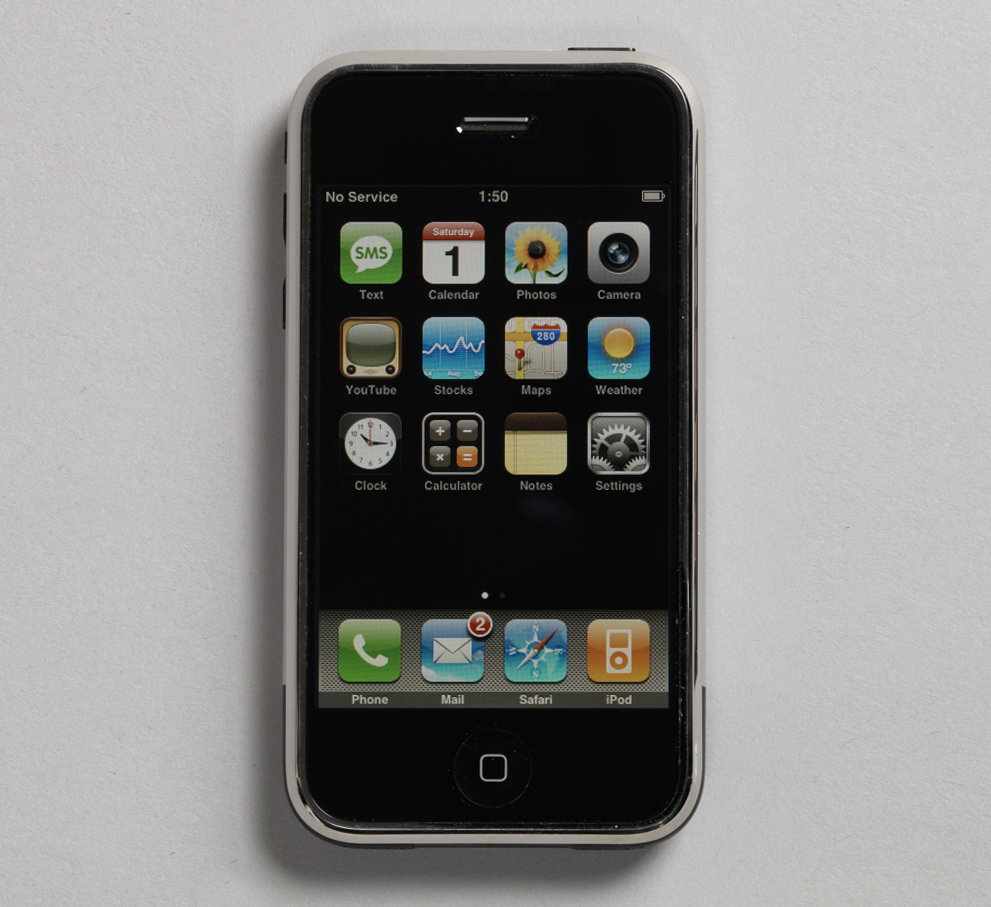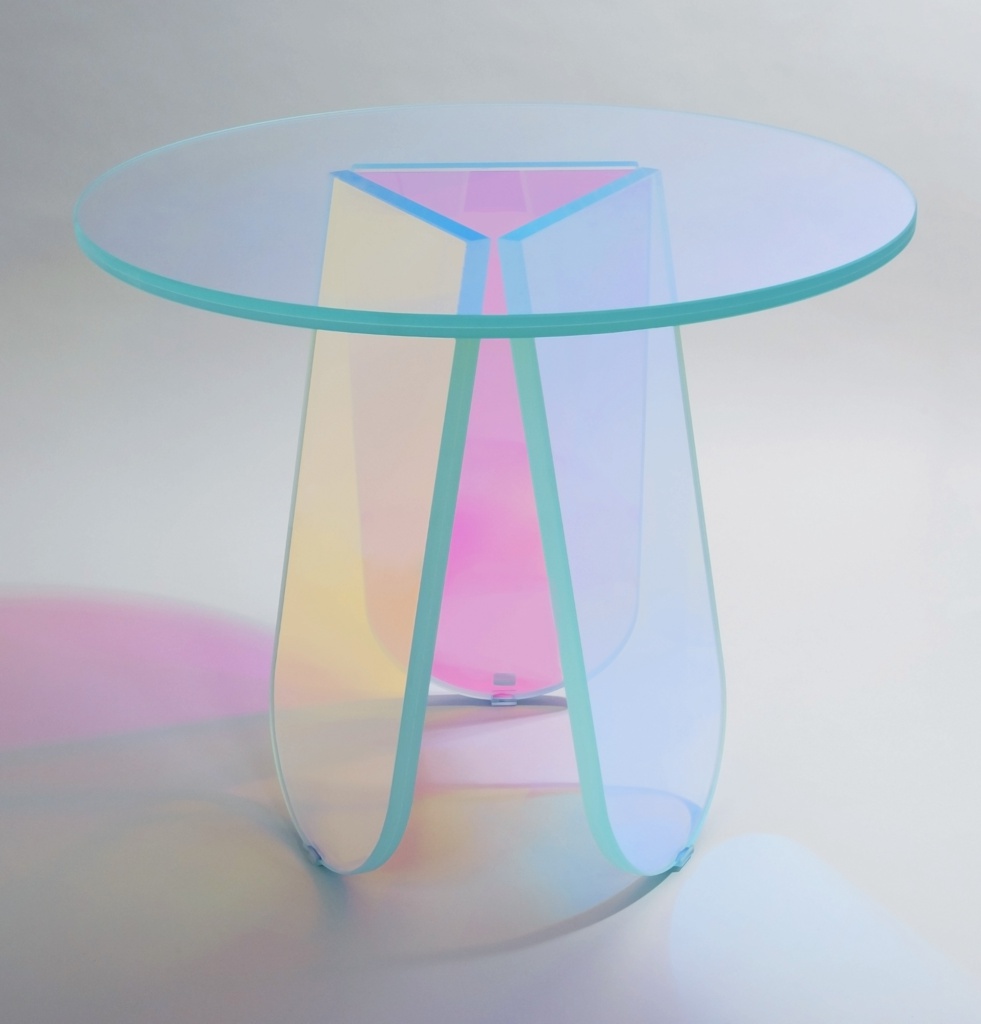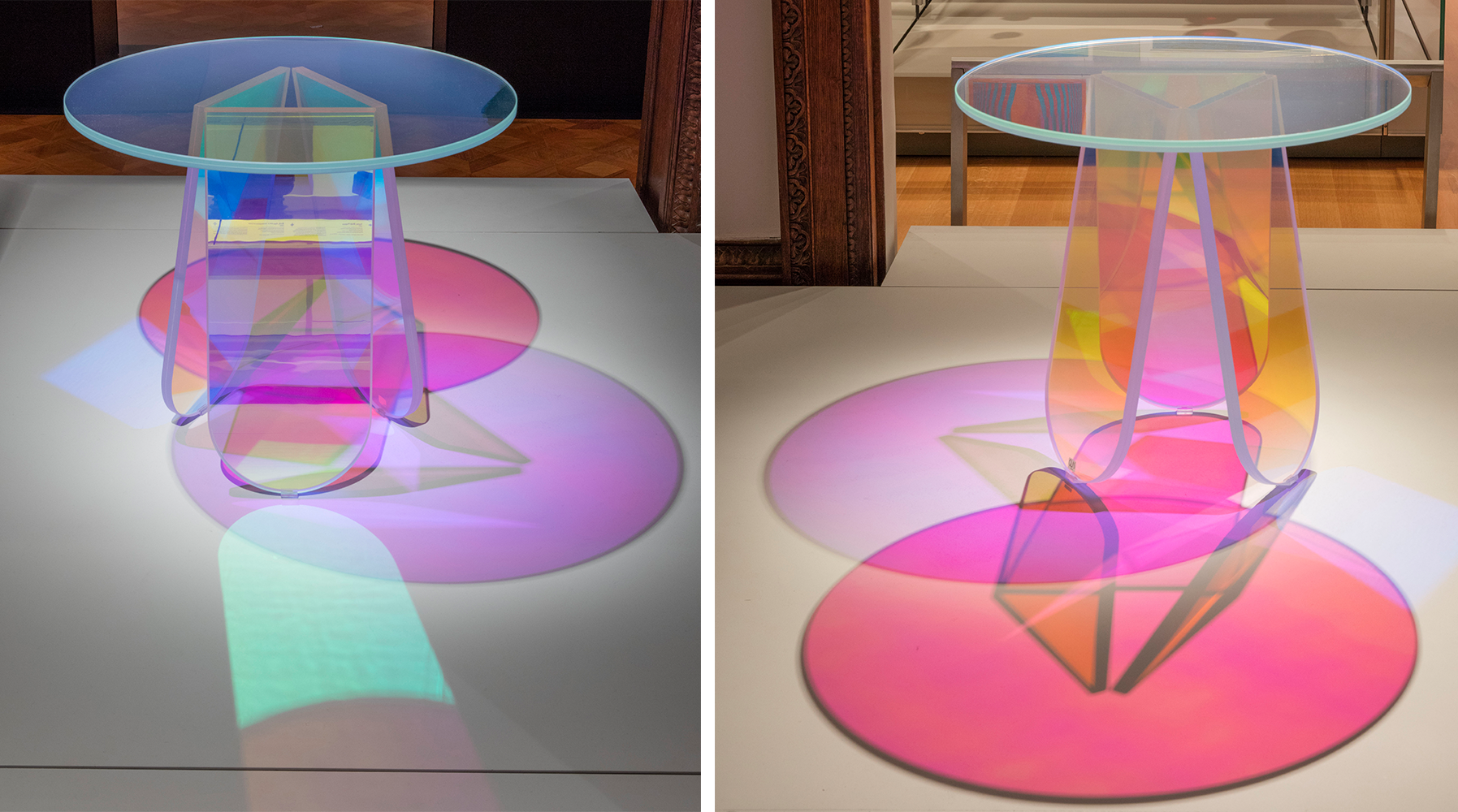The United Nations has designated 2022 the International Year of Glass. Cooper Hewitt is celebrating the occasion with a yearlong series of posts focused on the medium of glass and museum conversation. Catch up on the year so far.
Glass can seem like an incredibly fragile material. Most glass is not designed to withstand scratches or drops, shattering into thousands of pieces if it hits a hard surface owing to its brittle structure. But specialty glasses like laminated glasses, used for such objects as car windshields, are engineered to withstand even high impacts, like car crashes without injuring riders inside. If the glass is shattered, the small pieces are held together with a layer of plastic coating (often polyvinyl butyrate [PVB]) sandwiched between two thin layers of glass. Another approach to creating safety glass is called tempering, in which a selective heat treatment introduces stresses into the glass that cause it to shatter into small pieces that are less dangerous. Chemical tempering is used for Corning’s Gorilla Glass, used for the screens of many consumer electronics, including the first iPhone developed by Apple in 2007 when the glass was still in the research and development phase.[1] In Corning’s chemical tempering process, the glass is immersed in an ion-exchange bath that substitutes the larger potassium ion for sodium ions in the glass network. This means the outside surfaces of the glass end up in a compressive state while the inside balances out this force in tension, making it stronger and more scratch resistant.[2] Since Gorilla Glass also uses extremely thin and flawless drawn glass (as opposed to float glass) it is exceedingly thin, strong, and lightweight—all important design criteria for use in electronics.

iPhone Smartphone, Model 2G, 2007; Designed by Jonathan Ive (English, born 1967) and Apple Industrial Design Team; Manufactured by Apple Inc. (Cupertino, CA, USA); Plastic (ABS), polycarbonate resin, stainless steel, oleophobic coated glass, aluminum; H × W × D: 11.4 × 6.1 × 1.2 cm (4 1/2 × 2 3/8 × 7/16 in.); Gift of Roland L. Trope, 2009-29-1
Laminated glasses also allow a wide range of possibilities for aesthetic as well as technical effects. Spanish designer Patricia Urquiola’s Shimmer table (2014) produced by Glas Italia makes use of a special laminated glass with a multichromatic finish. Urquiola’s table is composed of flat sheets of glass offering a contemporary interpretation of plate glass furniture, a type of design explored at the 1939 World’s Fair in New York (see Cooper Hewitt’s blog post on a chair by the Pittsburg Plate Glass Company). With the multichromatic laminate, the Shimmer table appears as one color in reflected light while light that is transmitted through the surface appears as another color, creating a dazzling effect of color change that shifts as you move around the table (see below for photography of the table on display). This type of structural color is similar to iridescence (described in January’s Year of Glass post) in that it derives from the microscopic layered structure inside the material that bends light in different directions.

Shimmer Side Table, Model SH101, 2014; Designed by Patricia Urquiola (Spanish, born 1961); Manufactured by Glas Italia (Macherio, Italy); Laminated plate glass; H x diam.: 45 × 52 cm (17 11/16 × 20 1/2 in.); Gift of Glas Italia, 2022-21-1

The Shimmer table from two angles as displayed in Cooper Hewitt’s exhibition Saturated: The Science and Allure of Color (May 11, 2018–March 17, 2019).
Glass with different colors in reflected and transmitted light, such as the Shimmer table, is known as dichroic glass. This glass is a technology that first appeared in the late Roman period, with the most famous example being the Lycurgus Cup (circa 4th century CE), a cage cup of carved glass that changes from red to green. This type of dichroic glass was not common and very few examples (mostly small sherds) exist today, and it differs from laminated dichroic glass in that dichroism is formed by nanoparticles of gold and silver inside the glass melt (i.e. added to the hot liquid glass before it is worked) rather than in a microns-thin layer of coating applied on top of or sandwiched between two layers of glass. When colloidal particles (particles suspended in another substance) of gold scatter light inside the glass, it creates a ruby red color. The same optical effect is also used in gold-containing pink and red porcelain glazes.
The modern approach to making dichroic glass was developed by NASA for the space program in the 1960s to create filters that could protect spacecrafts from solar irradiation. Dichroic filters are also used in microscopy, photography, and stage lighting applications. This approach uses an energized electron beam to volatilize and deposit a very thin film of metal oxide (usually) onto the surface of glass in a vacuum, which creates an optical interference filter adhered to the glass surface.[3] Both the iPhone and Shimmer table make use of highly specialized forms of laminated glass, showing how diverse these products, and their purposes, can be.
Jessica Walthew is a conservator at Cooper Hewitt working with the product design and decorative arts and digital collections.
Notes
[1] Thomas Ricker, “What Happened to the Original iPhone’s Plastic Screen? / A Retelling of the ‘Hail Mary’ Play that Brought Glass to the iPhone,” The Verge, July 9, 2019, https://www.theverge.com/2019/7/9/20687299/plastic-iphone-gorilla-glass-origin-story-steve-jobs.
[2] Sophie Bushwick, “What Stresses Gorilla Glass Makes It Stronger,” Inside Science, May 17, 2013, http://www.insidescience.org/content/what-stresses-gorilla-glass-makes-it-stronger/1009.
[3] For a video of vacuum thin film deposition, see the website of contemporary manufacturer CBS glass: https://cbs-dichroic.com/faq/.
Further Reading
“From a Broken Flask: Laminated Safety Glass,” All About Glass (blog), The Corning Museum of Glass, October 25, 2011, https://www.cmog.org/article/broken-flask-laminated-safety-glass. Originally published in Innovations in Glass (Corning, New York: The Corning Museum of Glass in association with Ralph Appelbaum Associates, 1999) 18–20.
“Ultra-Thin Coatings Beautify Art,” NASA Spinoff, National Aeronautics and Space Administration, 2012, https://spinoff.nasa.gov/Spinoff2012/cg_2.html.
Whitehouse, David. “Roman Dichroic Glass: Two Contemporary Descriptions?” Journal of Glass Studies 31 (1989): 119–21. Published online on All about Glass, June 11, 2013. https://www.cmog.org/article/roman-dichroic-glass-two-contemporary-descriptions.